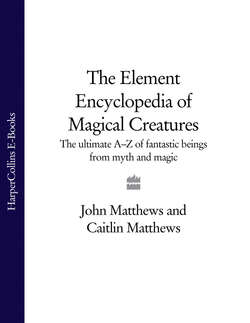Читать книгу The Element Encyclopedia of Magical Creatures: The Ultimate A–Z of Fantastic Beings from Myth and Magic - John Matthews - Страница 214
BEE
ОглавлениеThroughout the world, the bee has been revered as the bringer of sweetness and light, as people have always collected the honeycomb to sweeten their palate and used the wax from beehives and nests to make candles. In Spain, 8,000 year-old cave paintings at Cueva de la Araña show scenes of people collecting honey from a sheer rock face with the help of ropes. Bees are seen as idealized emblems of civilization, with their organized colonies. Respect for the bee has been shown because it was believed the bee was the only creature to have come from paradise completely unchanged by this world. Their industry and the manner in which they build their own intricate hive has impressed many cultures. You were highly favoured if bees built a hive on your land. It is perhaps for this reason that it has been necessary to ‘tell the bees’ any significant family news, to treat them as members of the family. It was not understood until modern times that the chief officer of the hive is the Queen Bee, early writers speaking of the King of the Bees instead.
Among the Maya of South America, bees were under the patronage of the god Ah Mucan Cab. Among the Chiriguane tribe of South America, the star constellation of the Pleiades is called the bees. Among the Aztecs, the god Quetzalcoatl goes on a journey into the Land of the Dead during which he is said to become a bee. In India, Vishnu, Krishna and Indra are termed ‘the nectar-born’ ones. Vishnu often appears as a blue bee perched upon a lotus, while Krishna is depicted with a blue bee on his forehead. This blueness denotes the colour of the sky and ether, the sacred fifth element, which can only be assigned to the gods, not to men.
In Egyptian myth, the sun god Ra’s tears turned into bees as they fell upon the earth. Egyptians saw the bee as the giver of life, and so they used the bee to represent birth, death and resurrection, as well as a symbol of chastity, balanced living and royalty. The king of Lower Egypt was called ‘he who belongs to the bee’ and the temple of the goddess Neith at Sais was called ‘house of the bee’.
In Greece, a similar connection was made between hives of bees and colonies of temple servants. The priestesses of Demeter were called melissae or ‘bees’, and the priestess of the oracle at Delphi was called the Delphic Bee. The word for a full-grown bee larva is ‘nymph’ and the Greek nymph Melissa was the first to discover honey as foodstuff. Greeks mixed honey with water to create hydromel, a celebratory drink. They associated honey with eloquence after the tuneful buzzing of bees, and many poets and orators have the nickname Chrysostom or ‘golden-mouthed’. It is said that the bees of Hymettus dropped honey upon the lips of Plato as he slept when a child, and that the poet Pindar was fed with finest nectar while he was a baby in his cradle. A similar epithet is used of poets among the Celtic peoples for whom mead was the sublime drink that was offered to heroes, imparting intoxication and ecstasy.
The same respect for honey was found among the Mazdeans of Persia, who saw it as the essential ingredient in the divine drink of soma. The Romans held that collectors of honey must be chaste or abstain from sexual intercourse or they might drive the swarms away. They also believed that sudden swarms of bees alighting in a place were bringers of bad luck: a headless bee was a symbol set up to ward against the evil eye. Among the Merovingian kings of early France, the bee was the ultimate emblem of kingship, and honey bees made of garnet and set with gold have been found in their hundreds in the burial of such kings as Childeric in the 5th century.
In Middle Eastern lore, the bee and the lion are frequently connected. This may have been because it was thought that bees were born from the carcasses of lion or oxen: this erroneous belief was based on the false observation that maggots in carcases become bees not flies. We find this belief echoed in the biblical story of Samson, where a dead lion yields bees and the saying ‘out of the strong came forth sweetness’, which is still quoted on containers of Tate and Lyle’s Golden Syrup. For early Christians, the bee was an emblem of Christ’s death and resurrection as well as the symbol of monks and clerics who gather about their abbot, bishop or pope and do his bidding with perfect obedience and industry.
